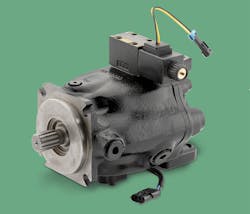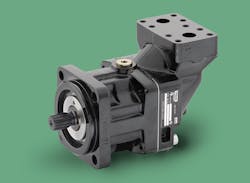The F12 series bent-axis hydraulic motor deliver operating pressures to 480 bar (7,000 psi) and speeds up to 7,300 rpm. Typical of bent-axis motors, the F12 motor has robust construction and can be used in both open- and closed-loop circuits. They are available in displacements from 30-250 cc/rev.
Purposeful Pumps
The P1 Series was chosen because of its high efficiency and power density. This combination provides high-efficiency power management by limiting torque to only that required by the load. Higher flow output at at different pressures and speeds allows the engine to use less fuel and produce less heat. This P1 pump was also equipped with a displacement sensor to monitor swashplate angle in real time. This allows users to achieve a more accurate flow output by closing the electronic loop via the sensor feedback, thereby allowing them to regulate overall vehicle power consumption more effectively.
The P1-045 pump used for the hydraulic fan drive system also features ripple chamber technology, which reduces noise and pressure pulsations. In conventional piston pumps, pumping chambers undergo wide changes in pressure with every revolution as they rotate through suction and discharge phases. These pressures create high reaction forces that, left unchecked, can cause cyclical deformation of pump case. Ripple chamber technology precompresses hydraulic fluid through each rotation of every pumping chamber to reduce the pressure pulsations, and, therefore, noise.
Measuring Equipment Performance
The results of the system lowered fuel consumption by more than 10%, exceeding the original goal. In addition, the system saves costs by simplifying the hydraulic system and reducing the number of components. It also provides better pump flow response and expands control versatility and stability that contribute to improved machine productivity.
Keith McDonald is product manager at Parker Hannifin’s Hydraulic Pump and Power Systems Div., Marysville, Ohio. For more information, visit www.parker.com/hps.
This article is based on an entry in Parker Hannifin’s Motion & Control Technology blogs. Click here to view the original material.



